Commentary: Using the Combination of Kerure Clamp and Serrated Punch to Decrease Transection Rate in Follicular Unit Extraction
Amit Shivaji Kerure1, Shaurya Roahtgi2*, Shashank Bansod3, Umesh Bilewar4
1Consultant dermatologist and hair transplant surgeon, Dr. Amit Kerure skin clinic, Navi Mumbai 400703, Maharashtra, India
2Consultant dermatologist and hair transplant surgeon. Dr. Shaurya’s skin clinic, A6, Ratandeep CHS, SV road, Andheri west, Mumbai-400058
3Consultant dermatologist and hair restoration surgeon, Hi-Tech Skin clinic and hair transplant Centre, Nagpur, Maharashtra, India
4Consultant dermatologist and hair transplant surgeon, Ozone clinic, Navi Mumbai, Maharashtra, India
Introduction
The success of hair transplant by follicular unit extraction (FUE) is heavily dependent on minimizing injury to the follicular units. One of the most important factors for this is keeping a low follicular transection rate (FTR). FUE is a relatively new technique and we as practicing surgeons should have a constant zeal to check for areas of improvement. The authors will be discussing the usefulness of a new instrument which they invented to improve extraction that is scoring1 and its further use with newer serrated type FUE punches2.
Physics of FUE Punch
In order to understand the superiority of serrated punches, we need to analyze the interaction of the punch and tissue at initial contact. A torque3 is applied to the punch which is nothing but the rotational equivalent of a force. If force is applied for a distance, it results in some work, similarly if torque is applied at an angle, it can also do some work. The rate rotation or the rate at which that angle changes is called rpm.
T = k x Hpn (where T = motor torque in lb-ft; k = constant; Hp = motor horsepower; n = speed of motor shaft in RPM) and T = Ft 9 R (where T = torque in lb-ft; Ft = tangential force; R = movement arm, ie, punch radius).3
A torque applied to the rotating punch produces a tangential force. When the punch makes initial contact with the tissue, the resultant force of the punch is in the direction of rotation. the tissue applies resistance to the rotation that is tangential force and if this applied force exceeds the friction or resistance force of the tissue, either the tissue is pulled in the direction of rotation or the punch tends to rotate over the tissue in the direction of rotation3. If the punch is prevented from rolling, the force results in a shear stress in the tissue. A Shear stress is a stress state where the stress is parallel to the surface of the material. When the shear stress developed exceeds the shear strength of the tissue, the tissue cracks or fails.3 The shear stress τ developed is directly proportional to the tangential force Ft and inversely proportional to the area of contact A (τ = Ft/A). If the area is small as in the case of a sharp punch, the resulting shear stress is higher. Thus, the shear strength of the tissue is exceeded quicker and the tissue fails or is cut quicker3.
Advantage of Serrated (sharp) Punch
A dull punch has a larger contact area which results in lower stress and hence a higher force may be needed to exceed the strength of the tissue. This higher force translates into a higher torque, and subsequently a higher twist or distortion of the tissue. Therefore, this force is much more difficult to control and to center about the follicle axis, which means more probability of transection and more buried grafts.
On the contrary, a sharp punch requires less force to cut the skin, so there will be no or minimal distortion of this skin follicle unit. This understanding further led to the development of serrated punches, where the contact of the sharp edge to the skin was further reduced resulting in better extraction outcomes3.
Use of Kerure Clamp for Extraction
In comparison to follicular unit transplantation (FUT), FUE is more challenging to the surgeon in terms of stamina and endurance because of the time-consuming nature of the procedure. It requires more patience and also commands a steeper learning curve due to skills like excellent hand–eye coordination, a delicate touch, excellent hand motor skills1,4. FTR can be much higher in FUE4, particularly in the lower occipital area because of the acute angle of the emergent hair (10°– 15°) from the scalp skin and the higher variance angle (15°–35°) between the hairs below the skin and at the point of exit above the skin1,5. The comparatively loose scalp in this area does not provide a stable platform for punching, which adds to the FTR1,6. Moreover, manual stretching for achieving counter traction, which is helpful in reducing FTR in these areas, is difficult to manage1. Most of the time manual stretching is not enough or cannot be maintained uniformly for longer duration because of fatigue. Many surgeons use larger amounts of tumescent anesthesia for easy scoring, but its overuse for creating tissue turgidity causes post-procedural swelling. Some skin hooks have also been developed for the purpose of traction but they need to be held by hand, they need to be adjusted constantly and they cover very small areas. Repeatedly changing the areas of anchorage can cause more damage to the tissue.
The authors developed a device (Kerure clamp, figure 1) to overcome these issues and also studied its effect on FTR in a comparative study.1 Using the clamp at the time of extraction resulted in a statistically significant improvement in the FTR scores. In addition, a few other observations were also made. The clamp eliminated the need of assistant for counter traction during scoring (figure 2a) as well as allowing one hand of surgeon to be completely free while scoring (figure 2b). It also reduced the need of tumescent anesthesia in donor area1. In lower occipital area, just superior to the nape of neck, there is inward turning of nuchal skull bone, and the overlying scalp skin is comparatively lax with increased skin mobility, which provides a less stable surface for the FUE punch and creates difficulty in engaging and aligning the punch during follicular harvesting phase, which increases the FTR (figure 3)5. This is precisely the reason why patients with a loose scalp are not the ideal candidates to undergo hair transplantation by FUE6. The FUE yield from this area can be increased as the skin can be stretched and made tight with the application of our instrument (Figure 4). This prevents as well as reduces the damage to the harvesting hair follicles because of movements during engagement with FUE punch used along with power drill. With the ability to use the lower aspect of the scalp to harvest donor hair follicles, a bigger field is offered to the beginners who may have higher FTR. The instrument once placed does need to be manipulated time and again as it a very large area of coverage, making it superior to hand held skin hooks.
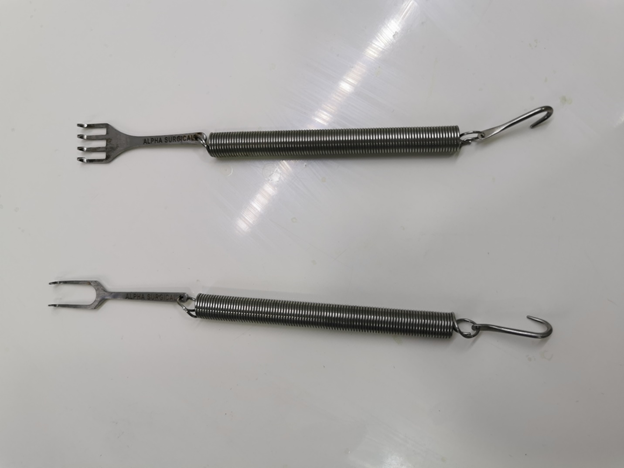
Figure 1: Kerure Clamp
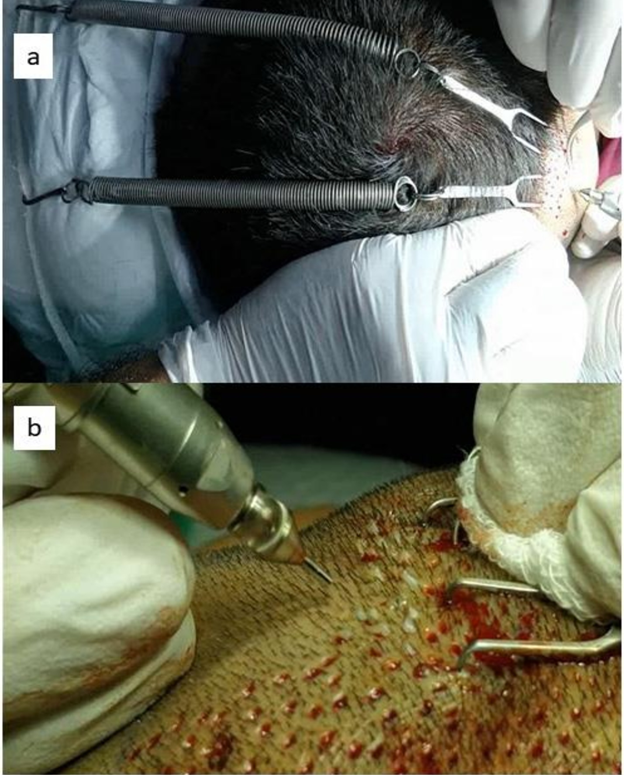
Figure 2a: Kerure clamp can be attached to a string or roll bandage with can be fitted to any operation theatre table
Figure 2b: Closer view of the clamp in situ showing the fangs inserted on the donor area
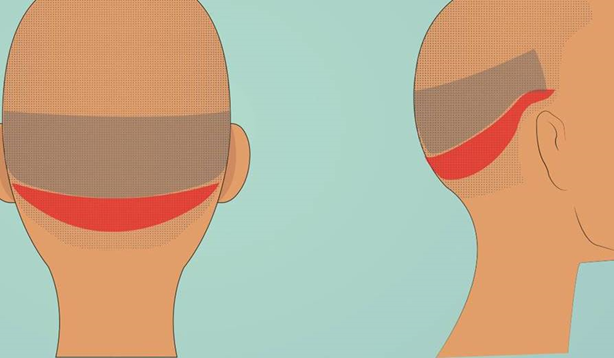
Figure 3: Red color area denotes the difficult area for extraction
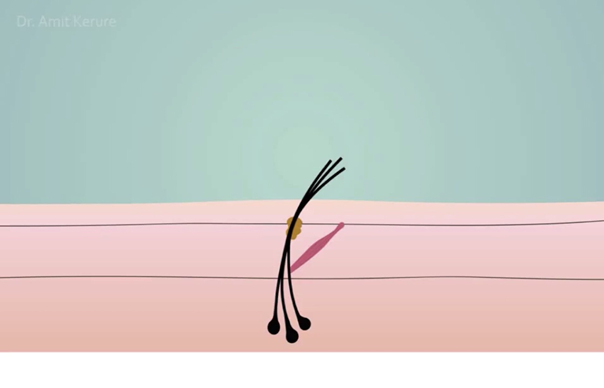
Figure 4a: The hair follicle without traction appears oblique and curved with respect to the skin surface
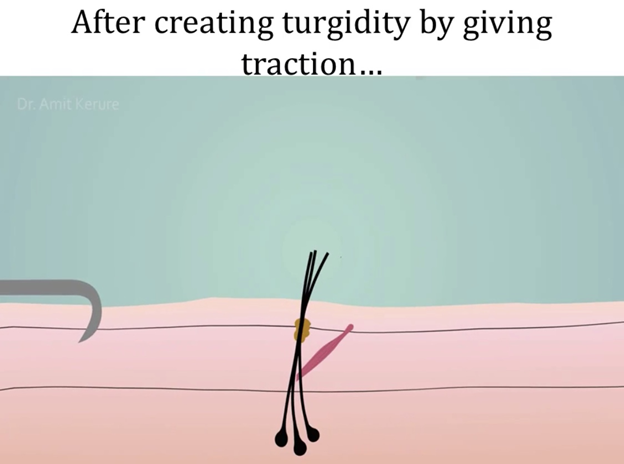
Figure 4b: The straightening of the hair follicle due to the traction of skin achieved using the clamp
Combining Kerure Clamp with Serrated Punch
When the rotatory punch makes circular incisions on the scalp skin, an opposing force is generated by the tissue. If the applied force on punching exceeds the opposing frictional force by a lot, then the chances of transection increase. The traction given by our device provides optimum opposing force against the force generated by the punch, thereby reducing the chances of transection. Hence, this only drawback of sharp punch can be effectively controlled by combining it with our new instrument. We hope that this article inspires further studies in this direction.
Conclusion
Kerure clamp reduces the angulations and provides a stable firm surface and completely removes the need for manual stretching. Serrations on the punch reduce the area of contact of punch over the tissue reducing follicular transection.
Serrated punches when used in combination with Kerure clamp, further reduces the FTR in FUE. Therefore, it increases the graft yield by helping in graft extraction in difficult areas. Higher yield gives better result. The combination of these 2 instruments increases graft scoring speed thereby increasing the surgeon’s efficacy and efficiency.
References
- Kerure A, Rohatgi S, Patwardhan N. Kerure clamp: A new age tool to improve extraction technique in follicular unit extraction. J Cutan Aesthet Surg. 2019; 12: 141-4.
- Kerure AS, Agrawal S, Dhurat R, et al. Using the combination of the Kerure clamp and serrated punch to decrease the transection rate in follicular unit extraction (FUE). J Am Acad Dermatol. 2019; S0190-9622(19)32439-9.
- Cole JP. A review of follicular unit extraction: FUE. www.coleinstruments.com/fue-review-follicular-init-extraction-hair-transplant.html. Accessed August 20, 2020.
- Williams KL Jr. Current practices and controversies in cosmetic hair restoration. Dermatol Surg 2013; 39: 797-801.
- Gharwade CR. Innovative modified hair follicle harvesting technique with reverse rake scalp elevator for lower occipital donor area in follicular unit extraction hair transplantation. Indian J Plast Surg 2016; 49: 390-6.
- Barusco MN. The no shave technique for FUE. In: Hair transplant 360 degree. Vol. 3. New Delhi, India: Jaypee Brothers Medical Publishers; 2014; 238.
